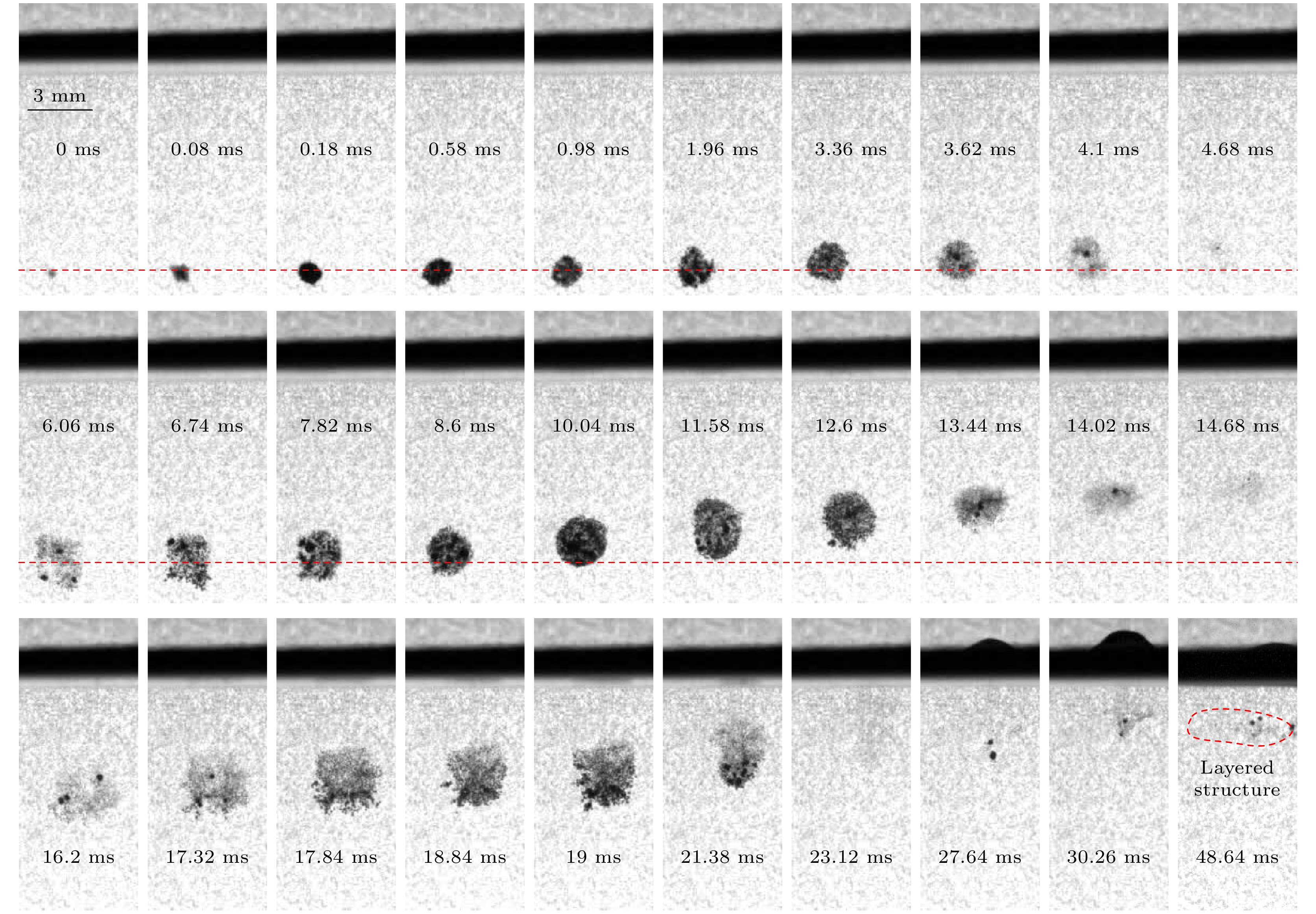-
The upwelling growth and evolution of spherical bubble clusters appearing at one-quarter wavelength from the water surface in ultrasonic cavitation fields at frequencies of 28 kHz and 40 kHz are studied by high-speed photography. Due to the interactions among bubbles, the stable bubble aggregation occurs throughout the rise of the bubble cluster, whose vertical pressure difference leads to a more significant spreading in the upper part of the cluster in the standing-wave field. At 28 kHz, the rising speed is about 0.6 m/s, controlled by the primary acoustic field. After a violent collapse of the bubble clusters, the aggregating structure begins to hover near the water surface. The size and stability of the structure are affected by the frequency and pressure of the primary acoustic field. If two clusters are close to each other, the clusters deviate from the spherical shape, even trailing off, and eventually merge into a single bubble cluster. By considering the influence of water-air boundary, based on the mirror principle, a spherical bubble cluster model is developed to explore the structure stability of the clusters, and the modified dynamics equations are obtained. The effects of driving acoustic pressure amplitude, bubble number density, water depth, and bubble equilibrium radius on the optimal stable radius of the spherical bubble cluster are numerically analyzed by using the equivalent potentials at 28 kHz and 40 kHz. The results show that the optimal stabilizing radius of spherical bubble cluster is in a range of 1–2 mm, and it tends to decrease slightly with the increase of the driving acoustic pressure and bubble number density. It is worth noting that the nonlinearity is enhanced by increasing acoustic pressure, which may promote the stability of the cluster structure. The smaller the unstable equilibrium radius, the easier it is to grow, and the stable size at 40 kHz is slightly smaller than that at 28 kHz. Generally, spherical clusters first appear in a high-pressure region and then move to a low-pressure region. If the acoustic pressure drops below a certain critical value, bubble clusters disappear. The theoretical analysis is in good agreement with the experimental observation. The analysis of the growth and structural stability of spherical bubble cluster is helpful in understanding the behavioral modulation of bubbles.
-
Keywords:
- spherical bubble cluster /
- cavitation structure /
- interfacial influence /
- stability
[1] 应崇福 2007 中国科学: 物理学 力学 天文学 37 129
 Google Scholar
Google Scholar
Ying C F 2007 Sci. Sin. Phys. Mech. Astron. 37 129
 Google Scholar
Google Scholar
[2] 程效锐, 张舒研, 房宁 2018 应用化工 47 1753
 Google Scholar
Google Scholar
Cheng X R, Zhang S Y, Fang N 2018 Appl. Chem. Ind. 47 1753
 Google Scholar
Google Scholar
[3] Ehsan Z S, Christian G, Helmut P, Christian J, Michael B, Cheistian B, Niels J, Christoph F D 2022 Ultrasound Med. Biol. 48 598
 Google Scholar
Google Scholar
[4] Plesset S M, Prosperetti A 1977 Ann. Rev. Fluid Mech. 85 145
[5] 陈伟中 2014 声空化物理 (北京: 科学出版社) 第231—236页
Chen W Z 2014 Acoustic Cavitation Physics (Beijing: Science Press) pp231–236
[6] Keller B J, Miksis M 1998 J. Acoust. Soc. Am. 68 628
 Google Scholar
Google Scholar
[7] Rasoul S B, Nastaran R, Homa E, Mona M 2010 Phys. Rev. E 82 016316
 Google Scholar
Google Scholar
[8] Bai L X, Xu W L, Deng J J, Gao Y D 2014 Ultrason. Sonochem. 21 1696
 Google Scholar
Google Scholar
[9] Yu A 2011 Phys. Rev. E 83 066313
 Google Scholar
Google Scholar
[10] Zhang W J, An Y 2013 Phys. Rev. E 87 053023.
 Google Scholar
Google Scholar
[11] Hansson I, Mctrch K A 1980 J. Appl. Phys. 51 4651
 Google Scholar
Google Scholar
[12] Wu P F, Bai L X, Lin W J, Yan J C 2017 Ultrason. Sonochem. 38 75
 Google Scholar
Google Scholar
[13] Li F, Zhang X M, Tian H, Hu J, Chen S, Wang C H, Guo J Z, Mo R Y 2022 Acta Phys. Sin. 71 084303 [李凡, 张先梅, 田华, 胡静, 陈时, 王成会, 郭建中, 莫润阳 2022 物理学报 71 084303]
 Google Scholar
Google Scholar
Li F, Zhang X M, Tian H, Hu J, Chen S, Wang C H, Guo J Z, Mo R Y 2022 Acta Phys. Sin. 71 084303
 Google Scholar
Google Scholar
[14] Parlitz O, Lauterbor W 1994 J. Acoust. Soc. Am. 96 3627
 Google Scholar
Google Scholar
[15] Akhatov I, Parlitz U, Lauterborn W 1996 Phys. Rev. E 54 4992
 Google Scholar
Google Scholar
[16] Appel J, Koch P, Mettin R, Krefting D, Lauterborn W 2004 Ultrason. Sonochem. 11 39
 Google Scholar
Google Scholar
[17] Li F, Zhang X M, Tian H, Hu J, Chen S, Mo R Y, Wang C H, Guo J Z 2022 Ultrason. Sonochem. 87 106057
 Google Scholar
Google Scholar
[18] Li F, Huang C Y, Zhang X M, Wang C H, Guo J Z, Lin S Y, Tian H 2023 Ultrasonics 132 106992
 Google Scholar
Google Scholar
[19] Xu K, Xu L, Zhou G P 2021 Acta Phys. Sin. 70 194301 [徐珂, 许龙, 周光平 2021 物理学报 70 194301]
 Google Scholar
Google Scholar
Xu K, Xu L, Zhou G P 2021 Acta Phys. Sin. 70 194301
 Google Scholar
Google Scholar
[20] Nasibullaevaa E S, Akhatovb I S 2012 J. Acoust. Soc. Am. 133 3727
 Google Scholar
Google Scholar
[21] Wang C H, Mo R Y, Hu J, Chen S 2015 Acta Phys. Sin. 64 234301 [王成会, 莫润阳, 胡静, 陈时 2015 物理学报 64 234301]
 Google Scholar
Google Scholar
Wang C H, Mo R Y, Hu J, Chen S 2015 Acta Phys. Sin. 64 234301
 Google Scholar
Google Scholar
[22] Elwin W V, Christopher F 2021 J. Acoust. Soc. Am. 149 2477
 Google Scholar
Google Scholar
[23] Joseph B, Keller, Ignace I, Kolodner 2004 J. Appl . Phys. 27 1152
[24] Christian V, Cleofé C P 2012 Ultrason. Sonochem. 19 217
 Google Scholar
Google Scholar
[25] Kyuichi Y, Yasuo I, Toru T, Teruyuki K, Atsuya T 2008 Phys. Rev. E 77 016609
 Google Scholar
Google Scholar
[26] Fabian R, Sergey L, Khadija A-B, Gunther B, Robert M 2019 Ultrason. Sonochem. 55 383
 Google Scholar
Google Scholar
[27] Mettin R, Akhatov I, Parlitz U, Ohl C-D, Lauterborn W 1997 Phys. Rev. E 56 2924
 Google Scholar
Google Scholar
-
图 8 泡团中心处气泡半径随时间变化曲线, n = 9×1012. f = 28 kHz, a = 11 mm, R0 = 6 μm (a)考虑边界; (b)不考虑边界. f = 40 kHz, a = 9 mm, R0 = 5 μm (c)考虑边界; (d)不考虑边界
Figure 8. Bubble radius at the center of the bubble cluster versus time, n = 9×1012: (a) With and (b) without considering the impacts of soft boundary, f = 28 kHz, a = 11 mm, R0 = 6 μm; (c) with and (d) without considering the impacts of soft boundary, f = 40 kHz, a = 9 mm, R0 = 5 μm.
图 12 球状泡团内气泡平衡半径对等效势的影响 (Pa = 150 kPa) (a) f = 28 kHz, a = 11 mm, 泡团内气泡占空比为0.0081; (b) f = 40 kHz, a = 9 mm, 泡团内气泡占空比为0.0047
Figure 12. Influence of the equivalent radii of small bubbles within the cluster on the equivalent potential (Pa = 150 kPa): (a) f = 28 kHz, a = 11 mm, and void ratio of the cluster is 0.0081; (b) f = 40 kHz, a = 9 mm, and void ratio of the cluster is 0.0047
-
[1] 应崇福 2007 中国科学: 物理学 力学 天文学 37 129
 Google Scholar
Google Scholar
Ying C F 2007 Sci. Sin. Phys. Mech. Astron. 37 129
 Google Scholar
Google Scholar
[2] 程效锐, 张舒研, 房宁 2018 应用化工 47 1753
 Google Scholar
Google Scholar
Cheng X R, Zhang S Y, Fang N 2018 Appl. Chem. Ind. 47 1753
 Google Scholar
Google Scholar
[3] Ehsan Z S, Christian G, Helmut P, Christian J, Michael B, Cheistian B, Niels J, Christoph F D 2022 Ultrasound Med. Biol. 48 598
 Google Scholar
Google Scholar
[4] Plesset S M, Prosperetti A 1977 Ann. Rev. Fluid Mech. 85 145
[5] 陈伟中 2014 声空化物理 (北京: 科学出版社) 第231—236页
Chen W Z 2014 Acoustic Cavitation Physics (Beijing: Science Press) pp231–236
[6] Keller B J, Miksis M 1998 J. Acoust. Soc. Am. 68 628
 Google Scholar
Google Scholar
[7] Rasoul S B, Nastaran R, Homa E, Mona M 2010 Phys. Rev. E 82 016316
 Google Scholar
Google Scholar
[8] Bai L X, Xu W L, Deng J J, Gao Y D 2014 Ultrason. Sonochem. 21 1696
 Google Scholar
Google Scholar
[9] Yu A 2011 Phys. Rev. E 83 066313
 Google Scholar
Google Scholar
[10] Zhang W J, An Y 2013 Phys. Rev. E 87 053023.
 Google Scholar
Google Scholar
[11] Hansson I, Mctrch K A 1980 J. Appl. Phys. 51 4651
 Google Scholar
Google Scholar
[12] Wu P F, Bai L X, Lin W J, Yan J C 2017 Ultrason. Sonochem. 38 75
 Google Scholar
Google Scholar
[13] Li F, Zhang X M, Tian H, Hu J, Chen S, Wang C H, Guo J Z, Mo R Y 2022 Acta Phys. Sin. 71 084303 [李凡, 张先梅, 田华, 胡静, 陈时, 王成会, 郭建中, 莫润阳 2022 物理学报 71 084303]
 Google Scholar
Google Scholar
Li F, Zhang X M, Tian H, Hu J, Chen S, Wang C H, Guo J Z, Mo R Y 2022 Acta Phys. Sin. 71 084303
 Google Scholar
Google Scholar
[14] Parlitz O, Lauterbor W 1994 J. Acoust. Soc. Am. 96 3627
 Google Scholar
Google Scholar
[15] Akhatov I, Parlitz U, Lauterborn W 1996 Phys. Rev. E 54 4992
 Google Scholar
Google Scholar
[16] Appel J, Koch P, Mettin R, Krefting D, Lauterborn W 2004 Ultrason. Sonochem. 11 39
 Google Scholar
Google Scholar
[17] Li F, Zhang X M, Tian H, Hu J, Chen S, Mo R Y, Wang C H, Guo J Z 2022 Ultrason. Sonochem. 87 106057
 Google Scholar
Google Scholar
[18] Li F, Huang C Y, Zhang X M, Wang C H, Guo J Z, Lin S Y, Tian H 2023 Ultrasonics 132 106992
 Google Scholar
Google Scholar
[19] Xu K, Xu L, Zhou G P 2021 Acta Phys. Sin. 70 194301 [徐珂, 许龙, 周光平 2021 物理学报 70 194301]
 Google Scholar
Google Scholar
Xu K, Xu L, Zhou G P 2021 Acta Phys. Sin. 70 194301
 Google Scholar
Google Scholar
[20] Nasibullaevaa E S, Akhatovb I S 2012 J. Acoust. Soc. Am. 133 3727
 Google Scholar
Google Scholar
[21] Wang C H, Mo R Y, Hu J, Chen S 2015 Acta Phys. Sin. 64 234301 [王成会, 莫润阳, 胡静, 陈时 2015 物理学报 64 234301]
 Google Scholar
Google Scholar
Wang C H, Mo R Y, Hu J, Chen S 2015 Acta Phys. Sin. 64 234301
 Google Scholar
Google Scholar
[22] Elwin W V, Christopher F 2021 J. Acoust. Soc. Am. 149 2477
 Google Scholar
Google Scholar
[23] Joseph B, Keller, Ignace I, Kolodner 2004 J. Appl . Phys. 27 1152
[24] Christian V, Cleofé C P 2012 Ultrason. Sonochem. 19 217
 Google Scholar
Google Scholar
[25] Kyuichi Y, Yasuo I, Toru T, Teruyuki K, Atsuya T 2008 Phys. Rev. E 77 016609
 Google Scholar
Google Scholar
[26] Fabian R, Sergey L, Khadija A-B, Gunther B, Robert M 2019 Ultrason. Sonochem. 55 383
 Google Scholar
Google Scholar
[27] Mettin R, Akhatov I, Parlitz U, Ohl C-D, Lauterborn W 1997 Phys. Rev. E 56 2924
 Google Scholar
Google Scholar
-
 8-20232008-Suppl video1.mp4
8-20232008-Suppl video1.mp4
 8-20232008-Suppl video2.mp4
8-20232008-Suppl video2.mp4
Catalog
Metrics
- Abstract views: 341
- PDF Downloads: 7
- Cited By: 0
















 DownLoad:
DownLoad:











